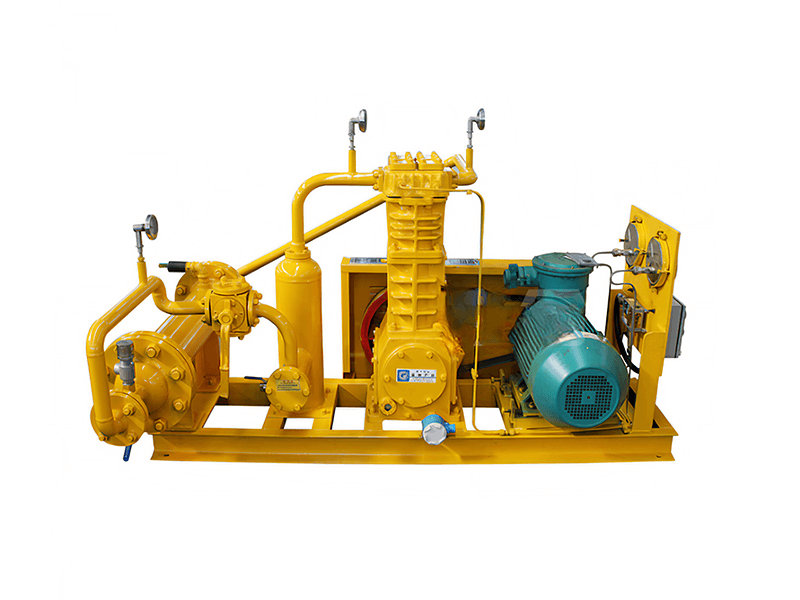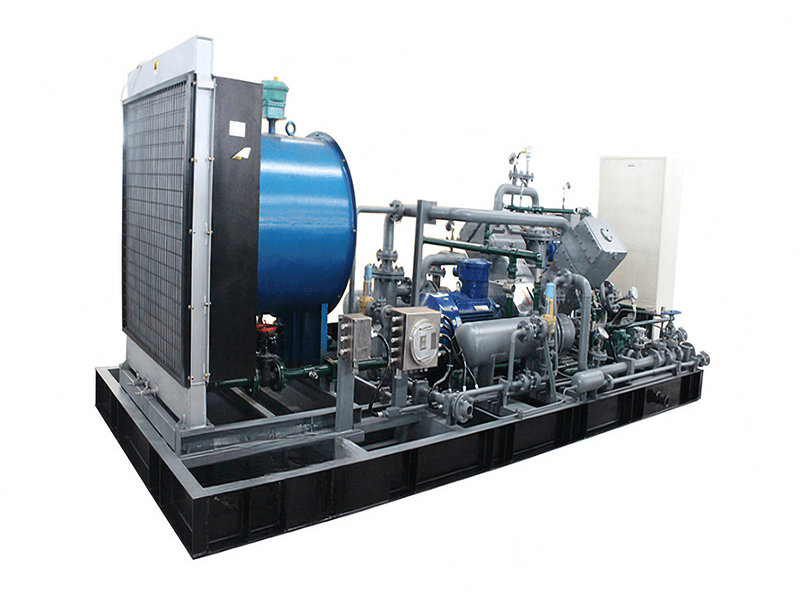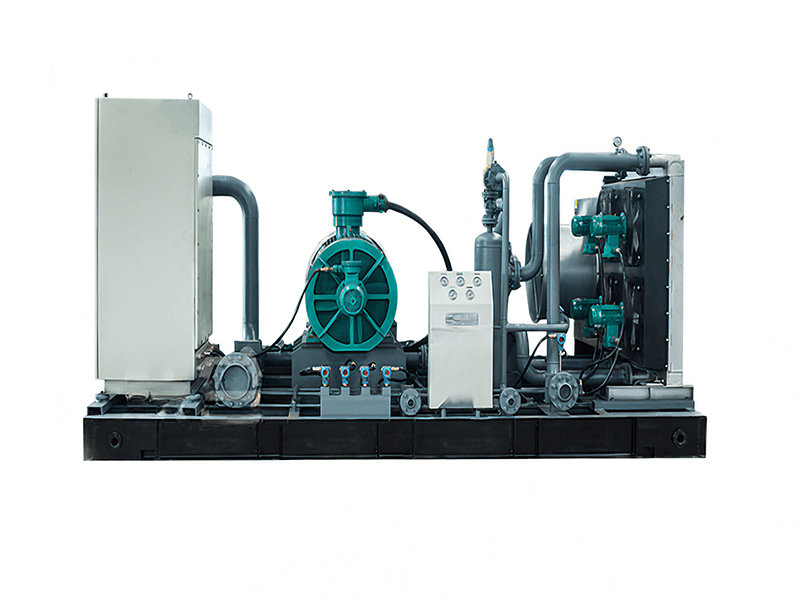Coalbed Methane (CBM), commonly known as "gas", is an unconventional natural gas adsorbed in the micropores of coal seams, with methane (CH₄) as its main component. Unlike conventional natural gas, coalbed methane extraction requires drainage and pressure reduction to desorb methane from the coal matrix. Its characteristics are high initial water content, low pressure and rapid decay, and high coal powder impurities. The efficient development of this clean energy is inseparable from the core driving role of the compressor.
1. Coalbed methane extraction: the four core functions of the compressor
1. Wellhead pressure increase and loss reduction
After the coalbed methane well is put into production, the pressure decays rapidly (from 3MPa to 0.5MPa within a few months). The low-pressure gas is pressurized to 0.8-1.5MPa through the wellhead screw compressor to avoid the "suffocation" of the gas well due to insufficient pressure. The recovery rate of a single well can be increased by more than 30%.
2. Gathering and transportation pipeline drive
Deploy variable frequency screw units at gas gathering stations to pressurize dispersed gas sources to 2.5-4.0MPa and input them into the trunk pipeline network. For example, the Qinshui Basin in Shanxi Province uses multi-stage compression to concentrate and pressurize the gas produced by dozens of wells and then transport them to the processing plant.
3. Purification and liquefaction pretreatment
The gas needs to be compressed to 15-25MPa before liquefaction (LNG) or purification (CNG). Oil-free reciprocating compressors have become key equipment for pressurization at the front end of liquefaction because they can avoid lubricating oil pollution.
4. Environmental protection and emission reduction closed loop
For the exhaust gas (ventilation methane) with a concentration of less than 30% during the extraction process, it is pressurized by a special oxidation compressor and sent to a catalytic device, converted into heat energy for utilization, and near-zero emissions are achieved.
Technical taboos: It is absolutely forbidden to use ordinary carbon steel compressors to process sulfur-containing coalbed methane (H₂S>50ppm), otherwise hydrogen embrittlement corrosion will cause the cylinder to burst.
Compressor type: oil-injected screw type
Applicable scenarios: wellhead boosting, main force of gas gathering station
Technical advantages: resistant to liquid water and coal powder (<50mg/m³) and long maintenance cycle (8000h)
Coalbed methane adaptability description: occupies 80% of the market share and requires a high-efficiency gas-liquid separator
Compressor type: dry screw type
Applicable scenarios: high-sulfur coalbed methane, liquefaction front end
Technical advantages: 100% oil-free output, resistant to H₂S corrosion (special coating)
Coalbed methane adaptability description: high cost, suitable for mining areas with sulfur content>5g/m³

Compressor type: reciprocating
Applicable scenarios: small flow rate high pressure ratio, CNG preparation
Technical advantages: high single-stage pressure ratio (up to 4:1)
Coalbed methane adaptability description: pre-fine filtration is required (coal powder <5μm)
Compressor type: centrifugal
Applicable scenario: external transmission and pressure boosting of large processing plants
Technical advantages: large flow (>200,000 m³/day) and pulsation-free operation
Coalbed methane adaptability description: only applicable to purified gas with deep dehydration and dust removal
III. Life and death line: safe restricted area of coalbed methane compression
1. Explosion due to excessive oxygen content
When the oxygen content of the gas is >5%, it may explode when encountering mechanical sparks. An online oxygen analyzer + emergency shut-off valve must be installed. The compressor of Shanxi Liulin Mine was blown up due to oxygen infiltration.
2. Coal powder wear and deposition
Coal powder concentration >100mg/m³ will rapidly wear the rotor, and carbon deposition at the valve plate will cause high temperature. Three-stage filtration (cyclone separation + filter bag + fine filtration) is mandatory, and the filtration accuracy must reach 3μm.
3. Liquid water hammer damage
Free water entering the cylinder will cause liquid hammer to explode the cylinder. The separator liquid level interlock system is a life-saving device, which must ensure that the gas-liquid separation efficiency is >99.9%.
4. Methane leakage monitoring
The compressor room must be equipped with a laser methane sensor (detection limit 0.1%LEL). The Huaibei project in Anhui Province caused a workshop explosion due to a seal leak, resulting in a loss of more than 10 million yuan.
4. Actual combat cases: Compressor-driven coalbed methane revolution
Case 1: Pressure boosting of well groups in Jincheng mining area, Shanxi
Challenge: The pressure of 300 wells fell below 0.3MPa, and the daily gas production of a single well was <500m³
Solution: Deploy 42 variable frequency oil injection screw machines (power 90-160kW), equipped with cyclone dehydration tanks
Results: Wellhead pressure increased to 1.2MPa, daily gas production increased by 220,000 m³, and investment payback period <2 years
Case 2: Utilization of wind-deficient gas in Fukang mining area, Xinjiang
Problem: The ventilation methane concentration is only 0.8%, which cannot be used by traditional technology
Breakthrough: Use ceramic piston special compressor (resistant to micro-oxygen environment) to pressurize the gas to 0.5MPa and then send it to the thermal storage oxidation device
Benefits : Annual destruction of 24 million m³ of methane is equivalent to reducing carbon dioxide emissions by 360,000 tons
Conclusion: From "coal mine killer" to "clean kinetic energy"
Compressor technology transforms coalbed methane from a suffocating mine disaster into a controllable green energy. Faced with a low-pressure, high-water-content, and high-impurity mining environment, oil-injected screw compressors have become the main force, and oil-free models are irreplaceable in the deep processing link. With the development of supercritical CO₂ fracturing technology, coalbed methane mining will advance to deeper coal seams in the future, which requires compressors to operate stably under a high temperature of 150°C and a high pressure of 30MPa - breakthroughs in materials science and sealing technology are pushing this energy revolution to a new depth.
According to the International Energy Agency (IEA), China's coalbed methane resources buried less than 2,000 meters deep reach 36.8 trillion cubic meters, equivalent to Russia's natural gas reserves. The popularization of efficient compression technology will make this "sleeping treasure" truly an important fulcrum for low-carbon transformation.


























